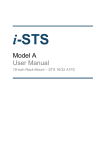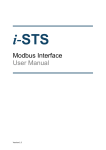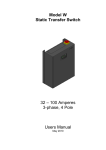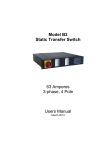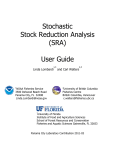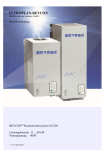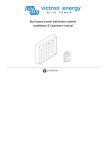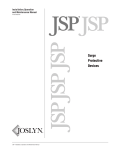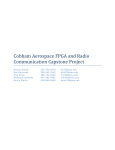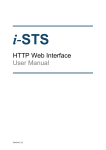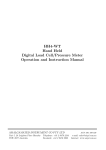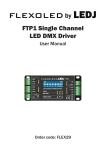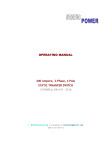Download i-STS Model G Static Transfer Switch 400 – 1600A Users Manual
Transcript
i-STS Model G Static Transfer Switch 400 – 1600A Users Manual April 2012 Contents 1. System Description 1.1 Static Transfer Switch 3 2. System Display Panel 2.1 Overview 5 2.2 Controls 6 2.3 LCD Display 7 3. STS Operation 3.1 Overview 10 3.2 User I/O & Controls 12 4. Maintenance Bypass 4.1 Overview 14 4.2 To Maintenance Bypass Procedure 17 4.3 Reinstatement from Maintenance Bypass Procedure 18 5. Fault Diagnosis 5.1 Interpretation of LCD Event List 19 5.2 Load Fault 22 6. Maintenance 6.1 Overview 22 7. Detailed System Description 7.1 Overview 23 8. Specifications 8.1 Operating Parameters 26 8.2 Main Item Components 27 9. Contact 9.1 Contact Details 28 2 1. System Description 1-1 1.1 Static Transfer Switch (STS) The Static Transfer Switch (STS) provides power and redundancy to items requiring / having only a single AC supply. The STS selects this supply from one of two input AC supplies. If one of the supply sources becomes unavailable the STS will automatically transfer the critical load to the alternative AC supply source. Manual selection of supply is also possible. This Static Transfer Switch has 3 identical and symmetrical switches, one for each phase of the 3-phase AC supply output. fig. 1. An example of a 3 pole STS This STS implementation uses Break-Before-Make transfer characteristics to ensure that the two sources are never paralleled so that the failure of one supply source has no impact on the other. The supplies can be truly independent. The installed STS is a 4 Pole switch (3-pole only shown in Fig 1) where the neutral is also switched. The arrangement for the 4th pole is identical to each of the poles as shown above. In the case for the neutral the transfer is overlapping. Upon incoming supply failure or degradation of the selected supply the STS immediately transfers the critical load to the alternative stand-by source. The break time is usually less than one millisecond, however under worst case conditions, can be up to 5 milli-seconds. In the case of down stream load fault conditions, the fault current drawn from the supply may degrade or damage the supply sources as a consequence should a fault current exist in the load the STS will inhibit a transfer to the alternate source even if this causes source supply degradation or loss. At least the fault will not be 3 1. System Description 1-1 transferred to the alternate supply with the possibility of degrading both sources. The current threshold for isolation is pre-set and is dependent on factors such as the capacity of the supply sources, line impedance and the line protection schemes employed for each STS. The STS is completely self-contained with its own detection, logic, display and controls. 4 2. System Display Panel 2-1 2.1 Overview. The system display panel consists of an LED mimic, LCD information display, (optional) and control pushbuttons. The optional LCD display is fitted to these units though it is not required for normal operation. 1 2 3 ! fig. 2. The system display panel. 1. LCD display 2. Control pushbuttons 3. MIMIC display 5 2. System Display Panel 2-2 2.2 Controls The LCD control pushbuttons are as follows: Scroll across for more Scroll down for next Transfer to alternate supply ! Cancel audible/acknowledge alarm/lamp test The TRANSFER pushbutton forms part of the mimic display and is standard on all units. The operator merely pushes the transfer pushbutton to effect a transfer to the alternate supply. The availability of supply 1 and 2 is indicated by their respective supply LEDs. The synchronization hold-off LED is located between the two supply LEDs. Green is in synchronism. LEDs 1 and 2 indicate which source is supplying the critical load. All LEDs are bi-colour where GREEN indicates the normal or on state. An alarm LED indicates an unacceptable, alarm or fault condition. Information as to the cause of the alarm condition is available from the LCD event history or the status LEDs located on the control board on the inside of the front door. The alarm LED and audible alarm (if available) can be cancelled by pressing the Alarms Cancel pushbutton below the ALARM LED. Transfers if inhibited by a control function can be reset by pressing the ALARM cancel pushbutton for 6 seconds. (Refer to fault and remedial actions that may be required first). 6 2. System Display Panel 2-3 2.3 LCD Display The LCD display provides information on the operation of the Static Transfer Switch. None of the function selections available on the LCD cause a change of source selection or STS state. The LCD menus are structured in a hierarchy through which the operator navigates by use of the LCD control pushbuttons. fig. 3. LCD Hierarchy The pushbutton exits the hierarchal tree and returns the operator to the Status Screen. From there the following submenus are available. 7 2. System Display Panel 2-3 2.3.1 Variables Menu This menu item shows the input & output variables. Output Voltage R, W & B phase. Output Current R, W, & B phase. Output Power Factor. Output Power (kWatts). Output Power (kVA) Frequency for each source 1 Source Input Voltage R phase. 1 Source Input Voltage W phase. 1 Source Input Voltage B phase. 2 Source Input Voltage R phase. 2 Source Input Voltage W phase. 2 Source Input Voltage B phase. Phase Angle between Sources 1 & 2 2.3.2 Events List Real time event list – 200 most recent events (see fault diagnosis section for explanation of events) 2.3.3 Settings Menu This menu item provides a facility for adjusting STS settings and calibrations. 2.3.3.1 Password Restricted access to set-up menus (optional menu item). 2 levels of access (000) and (123), can be changed by user 2.3.3.2 Date / Time Date and Time adjustment. This menu item displays general information about the equipment. 2.3.3.3 Contact details Service contact numbers. Model Specification, Software & Firmware revision status. 2.3.3.4 Internal Settings (Needs Special PASSWORD for access) Access to calibration submenus including: Source 1 Voltage Transient Hi /Lo Steady State Hi / Lo Source 2 Voltage Transient Hi /Lo Steady State Hi / Lo 8 2. System Display Panel 2-3 Output Voltage Transient Hi /Lo Steady State Hi / Lo Output Current Overcurrent Threshold Overload I2t (time and current) Settings Re-Transfer Delay / no of re-tries Preferred Source Selection Diagnostics 2.3.3.5 Synch Angle Detection Setting Provides access to adjust the allowable not in synchronism transfer. (Default is 9o and is adjustable between 5o – 30o), Manual transfers are inhibited when supplies are outside this range, however, automatic transfers will experience a 50 msec break, settable (0 – 150 msec). 2.3.4 Status This menu item provides details on the equipment operating status and event history. STS Status Status summary of the Static Transfer Switch. Provides information on any active alarm or fault conditions. Alarms Other active conditions and digital inputs. 2.3.5 Calibration Menus Used to adjust display accuracy (only or +/- 2 – 3 volts) 9 3. STS Operation 3-1 3.1 Overview The Static Transfer Switch control panel consists of an LCD display, LEDs and pushbuttons to provide information on the operation and status of the equipment. The LCD pushbuttons and LCD menu items cannot change the state of the Static Transfer Switch; this can only be done with the transfer pushbuttons, (except when incorrect settings are made). Selection of the required source to supply the critical load is made by simply pressing the transfer pushbutton for at least 2 seconds. Provided the supplies are within synchronization limits, the selected supply will be connected to the load. Verification is provided by the LCD and mimic LEDs. If the selected supply should vary outside preset limits and become unusable, the STS will automatically transfer the load to the alternative supply. The preferred source directive (preset able) will ensure that the STS will return to the preferred source if it is available and within acceptable limits, and after a settling time. The preferred source selection does not operate if the STS is manually transferred to the alternative supply from the controls on the front panel. Preferred source selection is pre-set by a mechanical slide switch inside the unit or via menu selection. Note that at power-up the STS will activate the preferred source, as pre-set by the slide switch, either supply 1 or 2. If no preferred source is set then the unit will not re-transfer to the original source after a fault in that source. 1 fig. 4. User control panel. 1. The preferred source selection switch, set to 0 (no preferred source) 10 3. STS Operation 3-1 Manual transfers override the preferred source selection, (operation of STS to alternate supply say S1 when preferred is S2, where S1 fails will transfer to S2 but not return back to S1). Preferred source selector can also be used to transfer the critical load. The Static Transfer Switch is fitted with two manual bypass isolators (refer fig. 1.). These are designated Q4 and Q5 where Q4 corresponds to the supply 1 switch and Q5 corresponds to the supply 2. These are mechanically and electrically interlocked to ensure that the two inputs 1 and 2 can never be permanently connected in parallel. Note that this is a standard option and can also be provided by others outside the STS. 11 3. STS Operation 3-2 3.2 User I/O & Controls These are located within the STS cubicle, bottom RHS of the panel, as shown. 4 1 2 3 fig. 5. User control panel. 1. Preferred source selection (pre-set) 0 No preferred source Supply 1 is the preferred source. If STS is forced to automatically transfer the critical load to the alternate (Supply 2) source the STS will 1 automatically transfer back to Supply 1 when again within tolerance and a pre-set settling delay. Supply 2 is the preferred source. If STS is forced to automatically transfer the critical load to the alternate (Supply 1) source the STS will 2 automatically transfer back to Supply 2 when again within tolerance and pre-set settling delay. 2. Control override (CAUTION: For maintenance only, this should not be used as a transfer control) 0 Normal – Automatic Control Override -> Supply 1 is forced to supply the critical load directly 1 overriding any internal control logic. NEVER attempt to operate the OVERRIDE switch if the supplies are not in synchronism. Control Override -> Supply 2 is forced to supply the critical load directly 2 overriding any internal control logic. NEVER attempt to operate the OVERRIDE switch if the supplies are not in synchronism. 3. RS232 PORT (The RS232 port implements a Modbus RTU (RS232). An adapter can be used to convert this to RS485) All settings and calibrations can be performed through the front LCD control panel. 12 3. STS Operation 3-2 4. User access CAUTION The power cabling should not be run adjacent to user controls. Separate these control cables from power circuits by at least 300 mm. The control signals are distance limited to 30 metres. All output relays contacts are rated for 50 V DC 1 Ampere (Not 240 V AC rated) User Remote Inputs (Voltage free contact closure controllers only) COMM Common return a Transfer to Supply 1 b Transfer to Supply 2 c Fire Stop (Causes both Switches to go off – loss of output - DISABLED) User Relay Outputs Relays are normally closed and held open in OK state (closed contact represents the alarm state). A B C D E F G General Alarm Not in Synchronism Supply 1 OK Supply 2 OK On Supply 1 On Supply 2 Overloaded 13 4. Maintenance Bypass 4-1 4.1 Overview Note if the Q1, Q2 or Q3 trip then the toggle is in the centre tripped position. To reinstate the user must first depress the toggle to the off position before being able to raise the toggle into the on position. Similarly for Q4 and Q5. In the case of a control failure the STS internal control logic can be overridden and the output can be forced to the correct state using the OVERRIDE switch to position 1 or 2 as appropriate. Remember that the switch needs to be in the centre “O” position for normal operation. The override provides control logic bypass only’ it does not provide an alternative path for the load power. NEVER attempt to operate the OVERRIDE switch if the supplies are not in synchronism. There is no interlock to prevent the switch from being operated when the supplies are not available or not in synchronism. Refer to the LCD variables display and mimic diagram for the not in synchronism state, (SYNC LED will be RED, variables display will show degrees out of synchronism. Only operate when less than 10 degrees). If the control is not operating you may need to use other means to determine that the supplies are in synchronism. Do not operate the OVERRIDE switch onto an absent supply. Do not defeat the mechanical and or electrical interlock scheme of Q4 and Q4. Do not operate the unit without the fans operating. e.g. Q1 & Q2 & Q3 must be open if fan fuses are removed CAUTION THIS EQUIPMENT RECEIVES POWER FROM MORE THAN ONE SOURCE. DISCONNECT OUTPUT AND ALL INPUT SOURCES OF POWER FROM THIS EQUIPMENT BEFORE SERVICING. WARNING HIGH LEAKAGE CURRENTS ON ISOLATED INCOMING AND OUTGOING CIRCUITS. EARTH CONNECTION IS ESSENTIAL BEFORE WORKING ON CIRCUITS OR CONNECTING / DISCONNECTING SUPPLIES. SEE INSTALLATION INSTRUCTIONS BEFORE CONNECTING / DISCONNECTING INPUT SUPPLIES. 14 4. Maintenance Bypass 4-1 Read this whole document thoroughly. Understand every aspect before proceeding. Request further assistance if you do not understand any aspect of the operation of the STS. Support and contact numbers are at the rear of the manual. Consider electrical distribution discrimination carefully. The STS has two incoming AC power isolators your upstream protective devices must discriminate with down stream protective devices and limit the peak fault current to less than 60kA so that when a fault occurs other items connected to the STS are not powered off by the opening of upstream protective devices. The upstream, STS supply breaker /fuse should only open if the down stream device protection is unable to trip or there is a fault within the STS. In case of down stream fault the STS will not transfer the fault to the alternate supply even if the voltage is adversely affected. Once the fault current has cleared the STS will resume normal operation protecting the critical loads from voltage disturbances, (10 second settling time). After following all of the considerations and precautionary processes in the last section and been successful and understanding, then no further special set-up is necessary. Each unit has been fully certified and heat soaked prior to shipment. The red LED ALARM should not be on. If it is check the following states. ON Supply 1 when priority is Supply 2 On Supply 2 when priority is Supply 1 Supply 1 or Supply 2 are not in spec. Override Switch is in position 1 or 2 Supply 1 & 2 are not in synchronism The unit is too hot (thermal bi-metal switch on H.S. activated) There is / was an overcurrent/ overload / load fault condition CAUTION REMOVAL OF PANELS EXPOSES DANGEROUS VOLTAGES ACCESS RESTRICTED TO QUALIFIED PERSONNEL ONLY Ensure from the supply that you are connected to on the STS is also the supply selected by the Maintenance Bypass Switch supply. If you have a remote maintenance bypass then it too should be in the normal position, prior to this step. Go to normal mode (Use switching procedure 3.1.2 to go on line). There should be no RED ALARM LED. (If there is press and hold for 10 seconds). Try using the TRANSFER push button to transfer to the alternate supply. To affect a transfer you need to push and hold the transfer pushbutton for at least 2 seconds. 15 4. Maintenance Bypass 4-1 The LCD should show that it is now powering the load from the other supply, (non preferred). If unsuccessful or the LCD is not functioning a transfer can be affected using the PRIORITY switch. Simply slide the switch to the desired supply, wait 2 seconds and check the LEDs and display to confirm. 16 4. Maintenance Bypass 4-2 4.2 To Maintenance Bypass Procedure. 1. If possible use the TRANSFER pushbutton to transfer the load to the desired source (Supply 1 or Supply 2). 2. Use the OVERRIDE slide switch (located lower RHS, near fuses, F1-F7) and operate to the 1 or 2 position corresponding to Supply 1 and Supply 2 that is presently supplying the critical load. 3. To transfer to Maintenance Bypass on Supply 1 operate the Q4 Maintenance Bypass Isolator to the ON position. (May need to reset the isolator to the off position before being able to turn ON). OR 4. To transfer to Maintenance Bypass on Supply 2 operate the Q5 Maintenance Bypass Isolator to the ON position. (May need to reset the isolator to the off position before being able to turn ON). 5. The critical load is now being supplied by the Maintenance Bypass Isolators. 6. Isolate the STS by opening the STS Output Isolator Q3, (Q3 toggle Right). 7. Before commencement of work on the STS it is necessary to open the incoming STS isolators Q1 and Q2. Note that dangerous voltages are still present within the STS. 8. To isolate the fans operate knife Fuses F5 & F6 by pulling from the top of the fuse holder. 9. To isolate electronics power operate knife Fuses F1, F2, F3 & F4 by pulling from the top of the fuse holder. Then remove the Auxiliary Station Control Fuses (located at the bottom of the LHS control cubicle). These are removed by unscrewing the fuse from the fuse holder. Do not operate the unit without the fans operating. e.g. Q1 & Q2 & Q3 must be open if fan fuses are removed 17 4. Maintenance Bypass 4-3 4.3 Reinstatement from Maintenance Bypass Procedure 1. Reinstate fuse F1 – F7, and the Auxiliary Station Control Fuses (located at the bottom of the LHS control cubicle). This will energize fans and electronics controls. 2. Ensure that OVERRIDE slide switch (located lower RHS, near fuses, F1-F6) is still operated to Supply 1 if Q4 is ON or Supply 2 if Q5 is ON. (by sliding to the 1 or 2 position corresponding to Supply 1 and Supply 2 respectively). 3. Close the STS incoming supply Isolators Q1 and Q2. Note that this energizes power to all internal power connections. 4. Press and hold the ALARM pushbutton for at least 6 seconds to clear any operational inhibit condition. Note that the ALARM LED will still be illuminated as the STS is not in the normal condition. 5. Check the LCD display and mimic and ensure that the correct supply has been selected, remove the OVERRIDE by setting the slide switch to the centre (“0”) position. Again check the LCD display and mimic and ensure that the correct supply is indicated. 6. Close Q3 by operating the toggle to the left Again check the LCD display and mimic and ensure that the correct supply is still indicated. 7. Open Q4 or Q5, (which ever is on) by pushing the toggle to the off position. 8. The load is now supported by the STS. 9. Use the TRANSFER pushbutton on the front control panel to select the desired source. Check and ensure that this corresponds to the PREFERRED source selection, (located above the OVERRIDE switch). 10. Check that the LCD display and mimic correctly reflect the state of the system and that the ALARM LED is off. 18 5. Fault Diagnosis 5-1 5.1 Interpretation of LCD event list Event Descriptor INITIALIZE Append WARM BOOT WATCHDOG TIMER STACK (+ Diagnosti c) (+ Diagnosti c) EEPROM ROM BATTERY COMMS CALIBRATION LOW POWER MODE S 1 / S2 / S3 1/2/3/4/5/ 6/7/8 1/2/3 ON/ OFF S 1 / S2 /S3 AVERAG EV (R,W,B TRANS V (Red, White, Blu) LOW /OK S 1 /S2 /S3 HI / OK SUPPLY 1 or 2 or 3 OVERRIDE PREFERRED S 1 / S2 LOCAL XFER FAILED / OK 0,1, 2 0,1, 2 FREQ LOW / HI /OK 1, 2 REMOTE XFER 1, 2 BACK FEED 1 or 2 on (R, W, B) OFF/ON S 1 / S2 / S3 REMOTE POWER SYNCRONISATION LOS / OK Description RAM CHKsum failed – Cold Start (RAM Corrupt) – Flash Defaults downloaded Power-up, Warm Start, re-initialize all but RAM – Keeps Event List Signals software / hardware problems STS Action Resulting None - Contact Static Power Stack or Heap has overflowed None - Contact Static Power FLASH/ EEPROM Checksum error – cal may be damaged FLASH ROM has been corrupted (Program is in error) Battery has low power (needs replacing) Communications has failed to Dig Proc, Ana1, Ana2, N1, N2 Calibration of MSP required LOW POWER MODE (Power Down Modes @ loss of electronics power) Supply 1 or 2 OR 3 has Steady State High or Low or phase R, W or B Supply 1 or 2 OR 3 has has Transient High or Low (1 sec) None - Contact Static Power* Supply 1 or 2 OR 3 has Steady State Low (1 sec) Supply 1 or 2 OR 3 has Steady State High (1 sec) Supply 1 or 2 OR 3 has Steady State High (1 sec) Controls Override set to S1 Preferred Source Set (0 or 1) Frequency of supply 2 is high or low Transfers to supply 2 if on 1 Local Transfer to Supply 1 or 2 requested Remote transfer to Supply 1 or 2 requested Back feed voltage too high on S1 or S2 Remote Supply off Requested (EPO) S1 & S2 not in synchronism User - Manual Action Normal After Black Start None - Contact Static Power None - Contact Static Power* None - Contact Static Power* None - Contact Static Power (can self repair) Contact Static Power * LOW POWER MODES Transfers to supply 2 if on 1 Transfers to supply 2 if on 1 Transfers to supply 2 if on 1 Transfers to supply 2 if on 1 User - Manual Switch Only User - Manual Switch Only Alarm No action Via User Inputs or BMS Contact Static Power Via User Inputs or BMS Alarm No action 19 5. Fault Diagnosis Event Descriptor Append CURRENT WARN / HIGH /FAULT/OK HEAT SINK TEMP HI /OK LOAD FAULT FAN THDI FLT/ CLR FAIL / OK HI / OK THDV HI / OK BREAKER OPEN Q1, Q2, Q3, Q4 or Q5 BREAKER Q1, Q2, Q3, CLOSED Q4 or Q5 TRIPPED Q1, Q2, Q3, Q4 or Q5 ALARM CANCEL POWER SUPPLY 1,2 or 3 SCR SC SCR OC S1,S2 R, W, B, N S1,S2 R, W, B, N 5-1 Description Output is overloaded (timed shutdown) STS Action Resulting Alarm No action starts timer Fans Failed or Over Stressed Device Temperatures, Heat Sink is Over temperature There was a fault at the load Status Indication Only Total harmonic Distortion of current is very high Total harmonic Distortion of Voltage is too high Status Indication Only No Action – Check & Reduce Loading or Ambient Status Indication Only Status Indication Only Alarm Cancel was pressed Status Indication Only SCR on S1 or S2 short circuit detected on phase # SCR on S1 or S2 Open circuit detected on phase # Does not transfer (Inhibit) No Action - Repair Alarm No Action – Check Load Alarm No action - Check Load Response to interlocking controls Response to interlocking controls Response to interlocking controls Resets Audible & Latched LED None -Contact Static Power / Repair Contact Static Power – Locks to safe source Contact Static Power – Locks to safe source 20 5. Fault Diagnosis 5-2 5.2 Load Fault In case of sustained high current output load faults, the STS will inhibit a transfer to the alternate supply even if this means degradation or loss of source supply. It is therefore imperative that you ensure that the discrimination with down stream and upstream protective devices ensures that the downstream protective device always clears the fault first. In case that all output is lost the faulty equipment should be located and removed from the STS output before re-instatement of power. At this point it is recommended that the source (1 or 2) be transferred to bypass to allow greater capacity to isolate down stream faults without affecting the source voltage integrity. It will be necessary to gain access to the STS internal maintenance bypass switch for 1 or 2 (switch Q4 or Q5) . The supply from the source in bypass mode should be selected by manual operation of the corresponding maintenance bypass switch. Application of this power should clear any downstream faults still present. The alarm pushbutton is then pressed for 10 seconds to reset the alarm conditions, followed by the transfer switch for the desired source to reinstate the STS to normal operation. When the LED mimic indicates that the STS is active again (the 1 or 2 LED is illuminated), the maintenance bypass isolator can be manually opened. If the RED LED ALARM led is lit then the user should interrogate the Event List to determine the cause. To clear / acknowledge some events the ALARM pusbutton needs to be operated (as some alarms are latched and some clear automatically when the condition returns to normal) Please also note that the VARISTOR fault is latched. Access to the latch RESET pushbutton is gained via the rear panel door. The Varistor Reset pushbutton is located at the lower RHS of the Varistor enclosure. Fan failures will also active the ALARM LED (and add an entry into the Event List. If the alarm has cleared the ALARM led will extinguish by pressing the ALARM pushbutton. Power Supply Failure of PSU1,2 & 3 for both the 12 V DC and 5 V DC will activate the ALARM LED (and add an entry into the Event List. If the alarm has cleared the ALARM led will extinguish by pressing the ALARM pushbutton. The station Auxiliary 5 & 15 V DC power supplies are not monitored. There is a green LED on each of these power supplies. This should be periodically checked. It should be Lit (Green) for correct normal operation. 21 6. Maintenance 6-1 6.1 Overview The STS s has been manufactured to provide a long, reliable and useful life. However, all equipment needs some maintenance. After the welcome sign you may be prompted to enter the date and time. This should be required the first time only. We strongly encourage the setting of the date and time so that real time event correlation can be undertaken. The Real Time Clock is thereafter battery backed up. If connected and / or the STS has been off for 1-2 months awaiting installation the battery requires replacement. We recommend that the battery be replaced every 5 years as a precautionary matter. Recommended Schedule: Once per month record the operating variables and compare with the units specifications to ensure that you are within its operating capability. Inspect the unit and note down any variations from last observation. Action may need to be taken and or reporting may need to be taken on these variances. Inspect the Event History and correlate any recorded events since last observation with real occurrences. Report / investigate any suspicious entries. Once every 6 months, (sooner if the environment is bad), vacuum dust from grills at front of unit. Inspect cable / plug connections for overheating. Units with fans need their fans changed every 5-7 years. This may need to be sooner if the environment is bad. NOTE: Please note that the user should not undertake repair procedures or gains access to the internal of the equipment. If the unit is faulty then it should be removed from service as per the accompanying procedure and a qualified experienced service agent should affect repair. 22 7. Detailed System Description 7-1 7.1 Overview The Static Transfer Switch (STS) provides power to items requiring a single AC supply. The STS selects this supply from one of two input AC supplies. If one of the supply sources becomes unavailable the STS will automatically transfer the critical load to the alternative AC supply source. Manual selection of supply is also possible. With reference to the accompanying schematic maintenance bypass arrangement has been adopted. the following operational Q1 and Q2 are the STS incoming supplies to the STS. They are always “ON” unless the STS requires isolation for maintenance. 1. Similarly Q3 is also always normally “ON”. 2. Power to the critical load is provided by either STS S1 or S2. 3. Should the operator wish to transfer the critical load to the alternate supply; say from S1 to S2 then the STS TRANSFER control pushbutton is used to achieve this. 4. Q4 and Q5, Maintenance Bypass isolator for Supply 1 and Maintenance Bypass isolator for Supply 2 respectively are normally always left “OFF”. These are mechanically interlocked so that only one can ever be closed. They are also electrically interlocked with the STS so that only the correct one can be closed, e.g. Q4 if on S1 OR Q5 if on S2. 23 7. Detailed System Description 7-1 5. If maintenance on the STS is to be undertaken then it is recommended that the system is transferred to ‘Maintenance Bypass’ using either Q4 or Q5. Only one of these will be able to be closed depending on the state of the STS. If the STS is supplying the critical load via S2 then only Q5 is able to be closed because of the electrical interlock between the STS and Q4 and Q5, (and also Q3). 6. A control override function exists that enables transfer to the alternate supply in case of STS controls malfunction. 7. Once on ‘Maintenance Bypass’, e.g. Q4 or Q5 are closed, it is advisable to open Q3 to isolate the STS from the critical load. This also facilitates testing of the STS. For convenience Q3 is automatically tripped open after 1 minute after the closure of the either Q4 or Q5. The Q3 can be re-closed at any time for re-instatement provided he correct state has been selected, e.g. when S2 is the maintenance bypass supply, Q5 is closed; for re-instatement, (closure of Q3) the STS must be selected to Supply 2. 8. Again if left unattended the Q3 will again be timed open, (if Lk 6 is in) 9. Once Q3 is open the STS can be tested in situ, transferring between S1 and S2, however, without any connection to the critical load because Q3 is open. 10. The above described control function is implemented using shunt trip devices such that if no supply is present (CB fuse is opened) or the STS is removed the control function is disabled and they operate as manual non controllable isolators only. 11. To achieve this functionality auxiliary contacts and shunt trips have been fitted to Q3, Q4 and Q5. The controls are implemented separately from the STS controls and the mode of failure of this control feature has been specifically designed to NOT interfere with or operate any of these isolators, however, if desired the Q3 trip facility can be disabled and operated fully manually, (default condition). 12. Q1 and Q2 are also able to be tripped by the system. This is only undertaken if there is a thyristor fault or a supply back feed condition and is not part of the normal operation. Note if the Q1, Q2, Q3, Q4 or Q5 trip then the toggle is in the centre tripped position. To reinstate the user must first depress the toggle to the off position before being able to raise the toggle into the on position. In the case of a control failure the STS internal control logic can be overridden and the output can be forced to the correct state using the OVERRIDE switch to position 1 or 2 as appropriate. Remember that the switch needs to be in the centre “O” position for normal operation. 24 7. Detailed System Description 7-1 The override provides control logic bypass only’ it does not provide an alternative path for the load power. NEVER attempt to operate the OVERRIDE switch if the supplies are not in synchronism. There is no interlock to prevent the switch from being operated when the supplies are not available or not in synchronism. Refer to the LCD variables display and mimic diagram for the not in synchronism state, (SYNC LED will be RED, variables display will show degrees out of synchronism. Only operate when less than 10 degrees). If the control is not operating you may need to use other means to determine that the supplies are in synchronism. Do not operate the OVERRIDE switch onto an absent supply. Do not defeat the mechanical and or electrical interlock scheme of Q4 and Q4. 25 8. Specifications 8-1 8.1 Operating Parameters Steady state Rating 630 Amperes RMS / phase including Neutral Overload capacity 110% 60 minutes any phase 125% 15 minutes any phase 300 - 600% maximum Synchronization Inhibit limit 9 degrees (0.5 msec) (Manual TRANSFER) 30 degrees Auto transfer (Under Supply Fault) (pre-settable 5 – 180 degrees) > 30 degree Break time 50 msec (20 – 150 msec) Steady State Transfer Threshold +/- 10% (1 second) settable Transient Transfer Threshold +/- 18% (sub cycle) settable Re-transfer (preferred source) time-out KA Capacity of unit Operating Voltage less than 3 seconds (0-15 sec) 35 kA +/ - 20% , THDV < 20% Protection: Electronic / voltage and current Open circuit device Short circuit device Output phase voltage imbalance Overload Load Fault Device Over-temperature Control Fault Ambient Over-temperature Operation Manual & Automatic Sense Preferred Source Selection 26 8. Specifications 8.2 Main Item Components Part Description THY1 – 1 to Thyristors 16 SNB1, DV/DT LIMITER SNB2 CT1-4 CURRENT TRANSFORMER 8-2 Manufacturer Dynex Part Number DCR3400V18 Rating 3400 Amps/ 1800 V, 60kA SP 1uF 10 Ohm 1000 v/usec CP8660 660 Amps :1 630 Amps Q1,Q2,Q3,Q 4& Q5 Circuit Breakers (power) University Paton instruments MGE F1 & F2 FI# SP009 SP002 SP003 SP003A SP011 SP023 Fans – Centrifugal Blower Fuses & terminals POWER CONTROL BOARD STS CONTROL BOARD DISPLAY BOARD LED Mimic BOARD USER I/O BOARD Neutral Control Board Ziehl Abegg Pheonix STATIC POWER STATIC POWER STATIC POWER STATIC POWER STATIC POWER STATIC POWER HW1(NS)630H-4P, c/w + Auxiliary switch +Shut trip 230 V AC RH31M4EK2C.1R ST10 SP017-02 SP002-01 SP003-00 SP003A-00 SP011-00 SP023-00 PLC FD1 PRS1-3 PRS4-6 PRS 7 SCR S/C DETECTOR FAN PROXIMITY DETECTOR POWER SUPPLY +HD POWER SUPPLY +HD POWER SUPPLY +HD MOELLER HIGHLY SENSOR MEANWELL MEANWELL MEANWELL EASY512-DA-RC TS18-08P-1 RS 150-15 RS-15-5 SP-200-15 PRS 8 POWER SUPPLY +HD MEANWELL SP-75-5 VARISTOR CT_VAR V_FUSE INCOMING VARISTORS VARISTOR PROTECTION VARISTOR FUSE VARSI SENVA FUSECO V385E60 C-1220 422000 240 V 50 Hz 10 Amperes 240 V AC n/a n/a n/a n/a n/a n/a 12 V DC 10 – 24 V DC /8MM +15 V 150 W +5 V 15 W 220 V DC +/-20% T TO 15 V DC 200W 220 V DC +/-20% T TO 5 V DC 75W 385 V, 60KA 0.75 - 50A CARTRIDGE 22X58MM GG V_HOLDER PROTECTION CARTRIDGE FUSE HOLDER FUSECO SFH22FW CONTROL RELAYS RELAY,INTERFACE\,POWER,P LUG IN, SPDT, COIL,LED,XT SERIES TE CONNECTIVITY XT314L12 RELAY BASE RELAY,DIN SOCKET,SCREWLESS, LOGICAL TERMINALS,PT SERIES TE CONNECTIVITY RT7872P FUSE 500V 100A SERVICE F/H FRONT WIRED TO SUIT 2258F 16A,12VDC 28 9. Contact 9.1 9.1 Contact Details For Service and Maintenance i – STS Manufacturing is a subsidiary of STATIC POWER PTY. LTD. ABN 42 101 765 913 Factory @1/13 Candlebark Court, Research, Victoria Australia, 3095 Mail to: , BOX 2003 Research Delivery Centre, Research 3095 Product Return / Repair: 1/13 Candlebark Court, Research, Victoria Australia, 3095 PH. +613 9437 0494, Fax +613 9437 0939 Email [email protected] [email protected] or visit www.i-sts.com.au 29






























